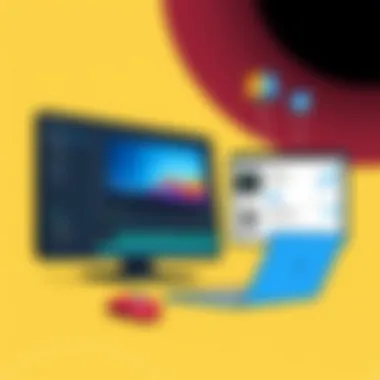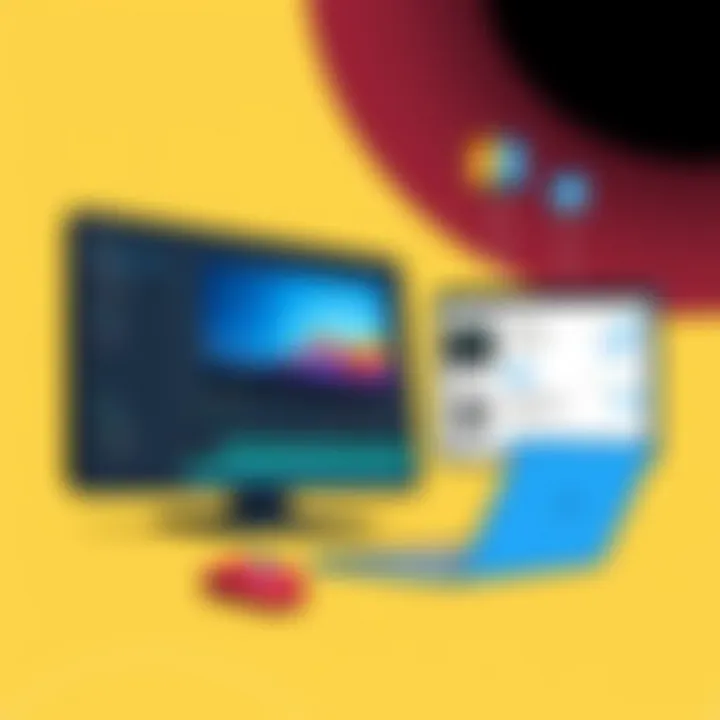An In-Depth Evaluation of Lightworks Video Editing


Intro
In recent years, the realm of video editing has evolved at a breakneck pace, driven by advancements in technology and an increasing demand for quality content across various platforms. With options ranging from simple mobile applications to sophisticated desktop software, finding the right tool for video editing can be a daunting task. Among the myriad of choices, Lightworks stands out, especially for those seeking a free yet robust solution for their editing needs.
But what makes Lightworks worthy of your attention? This article sets out to explore every nook and cranny of Lightworks, providing a detailed evaluation of this particular software. We’ll dissect its features, advantages, and challenges while drawing upon user experiences to paint a vivid picture.
As we dive deeper, our goal is to equip you—be you a tech-savvy individual, business owner, or creative professional—with the necessary insights to determine whether Lightworks aligns with your video editing requirements. You’ll be introduced to its functionalities, benchmarked against other software within the domain, and presented with actionable recommendations.
Let’s first delve into the Software Category Overview.
Prolusion to Video Editing Software
In today's digital landscape, video content holds a prominent place in communication, marketing, and storytelling. The advent of video editing software has democratized the ability to create high-quality videos, giving individuals and businesses alike the chance to share their stories visually. Choosing the right software is crucial because it directly impacts the editing experience as well as the final output quality. As the need for visually appealing content continues to rise, understanding the nuances of video editing software becomes essential for anyone looking to make their mark.
When diving into the realm of video editing, numerous factors should be considered. Firstly, the target audience is paramount—what appeals to a corporate client may differ vastly from the needs of a vlogger. Secondly, user experience matters, as a complicated interface can deter creativity, while a smooth, intuitive design can enhance it. Lastly, the software’s capabilities—ranging from effects to export options—should align with the user's goals. A tool that suits a simple social media post may not fulfill the requirements of a professional short film.
"In an age where video can make or break a brand, the art of selecting video editing software can't be taken lightly."
As we explore the world of free video editing options, it’s worth noting that these tools often provide robust features at no cost, making them accessible to all. However, this abundance can also lead to confusion. Many users ask whether these options can stand up to premium software in terms of reliability and performance. Therefore, understanding the core offerings of software like Lightworks is not just about identifying its features but determining how well it matches user needs without imposing financial constraints.
By examining both the importance of proper software selection and the various free options available, we can gain insights that empower prospective editors to make informed decisions. Whether for personal projects, professional work, or educational purposes, the right video editing software can be a game-changer, transforming raw footage into a compelling narrative.
Understanding Lightworks
In the realm of video editing, tools like Lightworks stand out due to their robust functionalities and flexibility. Understandably, many creators and professionals look towards their software of choice with a balanced mix of hope and skepticism. When discussing Lightworks, it isn’t just about its capabilities; it’s about the journey of learning and mastering its features. For those venturing into video productions, knowing the ins and outs of Lightworks can make or break the overall experience. This software is more than merely a tool; it shapes the workflow and influences the final product.
History and Development
Lightworks has an impressive pedigree in the world of video editing. Originally developed in 1989 for film editing, it has served countless professionals in the industry, becoming a staple for feature film production. Through the years, it evolved significantly from its basic roots to incorporate a wide array of advanced features that cater to those aiming for high-end edits.
Lightworks gained a reputation for not just being reliable but also for pushing creative boundaries. Its collaboration with notable filmmakers helped cement its status, making it a go-to choice for crafting award-winning films. Understanding this history provides insight into its stability, reliability, and the focus on user experience that has been consistent throughout its development.
Core Features
Across its journey, Lightworks has assembled a toolkit that is nothing short of comprehensive. Some of its core features can elevate a standard editing session into a remarkable endeavor.
Multi-Cam Editing
One standout feature is Multi-Cam Editing. Essentially, this allows users to synchronize and edit footage shot from multiple camera angles. It’s particularly useful for projects like interviews, events, and productions needing various perspectives. When multiple takes can be viewed and edited cordially, this becomes a powerful tool for storytellers.
The success of Multi-Cam Editing largely hinges on its intuitive interface, which simplifies what can otherwise be a convoluted process. Users can seamlessly switch between angles, blending them into a cohesive narrative. It is a vital choice for those who wish to maintain a professional edge in their editing work, contributing immensely to the overall goal of achieving polished visuals.
Real-Time Effects
The capacity for Real-Time Effects holds ground as another significant feature in Lightworks. This function allows users to apply effects as they edit, seeing immediate results without the need for lengthy render times. It provides a swift feedback loop, essential for maintaining creative momentum.
Real-Time Effects facilitate a more dynamic editing experience. Instead of waiting hours to see how filters and transitions interact, users can experiment and adjust on-the-fly. For many creatives, this capability can enhance the workflow while also unlocking new levels of creativity that static previews simply can't. It allows for an explorative editing style that can lead to unique end products.
Sound Mixing
Sound Mixing in Lightworks introduces users to a well-crafted audio workspace. The software doesn’t just handle visuals; it places equal emphasis on sound, understanding its profound impact on storytelling. With features that enable precise audio adjustments and effects, users can craft a well-rounded aural experience alongside their visuals.
Lightworks’ sound mixing tools allow different audio levels to be adjusted effortlessly, providing a robust setup for filmmakers wishing to create an engaging soundscape. It encourages a holistic approach to video crafting—where sound is not an afterthought but a core component of the finished product.
Installation and System Requirements
In the realm of video editing software, understanding installation and system requirements is crucial for a seamless user experience. This section delves into why it matters, particularly for users who might be venturing into editing for the first time or switching to Lightworks from another platform. Choosing suitable hardware and an appropriate operating system ensures that the software runs efficiently and effectively without hiccups. Users who don’t pay attention to these requirements could find themselves frustrated by crashes, lag, or unresponsive features.
Supported Operating Systems
Lightworks stands out for its compatibility with a variety of operating systems, which provides flexibility for users with differing preferences. Currently, it supports the following systems:
- Windows: Lightworks runs on Windows 10 and later versions. This is particularly appealing to the bulk of desktop users who rely on Windows.
- macOS: Apple enthusiasts can also join in. The software caters to macOS Mojave (10.14) and later versions, allowing creative professionals in the Apple ecosystem to harness its capabilities.
- Linux: For the open-source aficionados, Lightworks offers a beta version for specific Linux distributions, adding yet another layer of inclusivity.
Considering these operating systems, potential users can better assess their current setups and make any necessary adjustments. Those on less common configurations might need to explore alternative solutions, as not every video editing software accommodates every operating system.
Minimum Hardware Specifications


Every powerful software requires a beast underneath to run smoothly. Familiarizing yourself with the minimum hardware specifications of Lightworks is essential; otherwise, you could be at the mercy of your computer’s limitations. The following specifications are vital to keep in mind:
- Processor: A minimum Intel i7 or equivalent processor. For users, a robust processor ensures that video rendering happens quickly, and that the editing timeline responds fluidly.
- RAM: At least 8GB of RAM is necessary for basic functionality. However, 16GB is recommended for smoother multitasking, especially when managing high-resolution video files.
- GPU: A DirectX 12 compatible graphics card is needed, which can impact rendering times and playback quality. Subpar graphics can stall your workflow, making this a critical element.
- Storage: Minimum 250MB of storage space for the application, but users should have additional SSD or HDD space when working with large video files or projects. It’s advisable to keep some space aside for cache and backups.
"Investing in hardware that meets or exceeds these specifications can drastically change the user experience, transforming creativity into reality rather than tech hurdles."
User experience dramatically improves with the right hardware, and knowing these specifications upfront can save a lot of time and effort down the line. Tech-savvy individuals and business owners must weigh these factors to assess the genuine feasibility of integrating Lightworks into their workflow, ensuring they can hit the ground running.
User Interface and Experience
In the realm of video editing, the User Interface (UI) and overall experience stand as key pillars that can make or break a programmer's day. A well-designed UI allows editors to focus on their creative work rather than getting lost in a maze of complex buttons, dropdowns, and menus. As tech-savvy individuals, business professionals, and IT specialists delve into Lightworks, understanding how to navigate its interface smoothly becomes essential. The UI offers intuitive workflows which can lead to increased productivity while minimizing frustration. A seamless user experience can often enhance the ability to manipulate footage and effects effectively, ultimately resulting in a more satisfactory editing process.
This evaluation will clarify how navigating the Lightworks interface operates and how customization options can further tailor this experience to fit individual needs.
Navigating the Lightworks Interface
Stepping into Lightworks for the first time may feel a bit like attending a royal gala without a map. The array of panels, toolbars, and playback windows can be overwhelming. However, once you grasp the basic layout, the journey becomes less treacherous.
When you open Lightworks, you are greeted by multiple sections within its interface:
- Project Browser: This section lets you manage various projects, making it simple to start fresh or revisit old work.
- Editing Panel: The heart of the software, where dragging and dropping clips feels second nature. Here, you can trim, split, and compile footage seamlessly.
- Monitor Windows: This allows you to view your clips and changes in real time, giving immediate feedback on your edits.
- Timeline: The timeline lays out your project, providing an overview of all your clips, audio tracks, and effects.
As the saying goes, Rome wasn’t built in a day. Familiarity takes time, but the more you engage with the interface, the more intuitive it becomes. Watch tutorials and practice through hands-on experience for the best results.
Customization Options
While Lightworks provides a solid foundation, customization allows users to tweak their interface to suit their own workflow preferences. It’s akin to setting a dining table — each person has a unique style. Here’s how Lightworks accommodates varied user needs:
- Workspace Layout: You can alter the arrangement of panels according to what feels right for you. Whether you prefer a cluttered or minimalist setup, Lightworks caters to both approaches.
- Keyboard Shortcuts: Familiarizing yourself with customized shortcut keys can drastically improve efficiency. You can even create your own based on your editing style, making repetitive tasks a breeze.
- Theme Settings: Prefer dark over light? Lightworks allows you to switch the theme, which can help reduce eye strain during long editing sessions.
Customization isn’t just about aesthetics; it’s about enhancing your workflow and making the software truly yours. This degree of control can turn a good user experience into a great one, boosting satisfaction and productivity.
"A seamless experience is what every editor hopes for, transforming the cutting room into a space of creativity."
Performance and Reliability
In today’s world where content creation is on the rise, the performance and reliability of video editing software cannot be overstated. The efficacy of Lightworks hinges on its ability to seamlessly manage the demands of both amateur and professional videographers. Many aspects contribute to the overall performance, including processing speed, user interface fluidity, and hardware compatibility. A program that lags or crashes can frustrate users and hinder creativity. Therefore, assessing these factors is crucial for anyone considering Lightworks as a viable editing option.
Speed and Smoothness of Operation
A swift editing experience is essential for maintaining the creative flow. Lightworks is designed to optimize speed, allowing users to engage with their work without any annoying hitches. Users frequently praise its ability to handle high-resolution footage without breaking a sweat.
- Pre-importing assets: Lightworks boasts a predefined workflow that ensures assets are ready to go as soon as you start editing. This minimizes the waiting time and keeps you in the zone.
- Editing performance: The software efficiently manages real-time effects and edits while maintaining a smooth playback. For instance, when working with 4K video, users report minimal lag, supporting a professional-grade editing experience.
However, the speed can vary based on hardware specifications. Investing in compatible hardware, particularly a solid-state drive and sufficient RAM, will enhance the editing experience significantly.
Stability During Playback
Stability is another cornerstone of a reliable editing software. No one wants to face random crashes right before a deadline. Lightworks generally demonstrates a commendable level of stability, which is vital for serious projects. Users often note that it rarely experiences crashes during playback, which is a breath of fresh air in the world of video editing.
"The last thing you want while rendering your masterpiece is for the software to unexpectedly shut down. In my experience, Lightworks has been a solid companion through the editing process."
To further reinforce its steadfastness, regular updates contribute to optimizing performance, which addresses potential bugs and enhances user experience. Frequent updates also reflect commitments to improving the software, responding to community feedback and adapting to advancements in technology.
Export and Sharing Options
In the realm of video editing, the endgame is not just crafting an engaging piece but also how seamlessly it can be shared with the audience. Exporting and sharing options form a crucial part of any video editing software, influencing user experience and satisfaction. When a creator finishes an ambitious project, the last thing they want is to get stuck trying to figure out how to export their work efficiently or share it across platforms.
Supported Formats and Resolutions
Lightworks provides a multitude of export formats that cater to a variety of needs. It supports common formats like MP4, AVI, and MOV, ensuring that users can select one that best fits their target audience. Not only does it cover well-known video codecs, but it also offers the flexibility to work with high-definition formats, giving editors the option to export in resolutions ranging from standard HD (720p) to full HD (1080p). This means that your videos can look crisp and professional, irrespective of where they are played.
- Common Formats:
- MP4
- AVI
- MOV
The availability of various resolutions can have real-world implications too. For professional use, exporting in higher resolutions like 4K can make a significant difference in the quality of the final product, especially for theatrical releases or high-end corporate presentations. Moreover, these options can also enhance the viewing experience on platforms that support high-definition playback, capturing every detail the editor painstakingly included.


"Great video editing software should not only facilitate the creative process but also make sharing the results a breezy experience."
This sentiment is echoed by many users who value the ease of getting their finished video out into the world without bearing the burden of cumbersome processes.
Integration with Social Media Platforms
What good is a beautifully edited video if it cannot easily reach its audience? Lightworks anticipates this need by incorporating features that enable seamless sharing directly to various social media platforms. This integration is a game changer for creators focused on distributing their content widely without red tape.
Integrating with popular platforms like Facebook, YouTube, and Instagram means users can export their projects and publish them with just a few clicks. This is particularly beneficial for content creators who thrive on instant feedback and engagement from their audience. The software typically provides presets tailored for each platform, ensuring optimal video quality and format suitability, which spare users the headache of additional encoding or adjustments later on.
Moreover, sharing directly through Lightworks not only saves time but also helps maintain the quality of the video, as multiple export-processing stages are often eliminated. Facilitating such options empowers every user, from online influencers to corporate professionals, enhancing their ability to connect with viewers effectively and efficiently.
In summary, the export and sharing capabilities of Lightworks encapsulate its user-friendly ethos, enabling creators to focus on what they do best—telling stories. The combination of supported formats, resolutions, and social media integration underscores its value, positioning Lightworks as a credible choice for both amateur and professional editors alike.
Comparative Analysis
In the realm of video editing, navigating through the available software can feel like walking through a labyrinth. Each piece of software offers its own unique set of tools, user experiences, and strengths. This comparative analysis is crucial, as it arms users with the knowledge needed to choose the best video editing software for their specific needs. Through comparison, individuals can examine how Lightworks stacks up against other free editing tools, allowing for informed decisions and clearer expectations about functionality and usability.
Lightworks vs. Other Free Video Editors
When it comes to comparing Lightworks with other noteworthy free video editors, it unveils a range of capabilities and idiosyncrasies that set each option apart.
Shotcut
Shotcut prides itself on a user-friendly interface that welcomes newcomers while still offering robust features for seasoned editors. Its open-source nature allows for frequent updates driven by community input. One key characteristic of Shotcut is its extensive support for various formats, accommodating nearly every possible video file type. This flexibility makes it an appealing choice for those in need of a quick fix without the hassle of format conversion.
A unique feature of Shotcut is its ability to handle resolutions up to 4K without breaking a sweat. This edge provides Shotcut users with clear advantages in script-heavy video productions, particularly for those aiming at high-resolution outputs. However, some users might find its interface slightly less polished compared to other options, which could impact the editing flow for those looking for an aesthetically pleasing workspace.
DaVinci Resolve
DaVinci Resolve is often hailed as the gold standard for video color grading, making it stand out in this comparative analysis. Its impressive capabilities in color correction and professional-grade audio editing are phenomenal contributions to anyone looking to achieve cinematic quality. While Lightworks excels in multi-cam editing, DaVinci’s strength lies in visual effects and color enhancements.
The headline feature here is the Fusion module, which opens up a world of possibility for motion graphics and visual effects. This makes it a favored tool among professional creators or students aiming for polished presentations. However, it can be a bit overwhelming for users just starting out, as the learning curve can feel steep at first.
HitFilm Express
HitFilm Express introduces an interesting blend of video editing and visual effects capabilities, making it suitable for creators who thrive on creativity. A significant aspect of this software is that it allows users to combine 3D compositing with video editing seamlessly. For those interested in crafting short films or integrating special effects, HitFilm Express can be quite beneficial.
One standout characteristic is its comprehensive library of VFX tools, providing users with many options to enhance their project. Nonetheless, this feature-rich software can be resource-heavy and might require a robust computer setup to run smoothly. Users with low-spec systems may face performance issues, which could turn them away from utilizing HitFilm in its full potential.
Strengths and Weaknesses of Lightworks
Lightworks is no slouch when it comes to functionality. One of its main strengths lies in its powerful multi-camera editing capabilities, making it a strong player for narrative filmmakers and professionals working on more complex projects. On the flip side, one weakness could be its somewhat restrictive export options in the free version, potentially limiting how some creators utilize the software for broader distribution.
In summary, an effective comparative analysis reveals that while Lightworks stands tall among free video editors,\ it’s essential for users to take stock of what other tools bring to the table. By weighing these strengths and weaknesses against their personal or professional editing needs, editors can find their best fit in the crowded landscape of video editing software.
Use Cases and Real Applications
The realm of video editing software is expansive, but when it comes to Lightworks, one can't overlook the value of understanding its practical applications. Knowing how this tool fits into various contexts is crucial for potential users. It is not just about the features on paper but how these features translate into real-world usage. This section aims to shed light on the diverse environments where Lightworks can truly shine, helping creatives and technical professionals alike understand where it can be effectively leveraged.
Lightworks in Professional Settings
In professional settings, the stakes are high. Here, speed, efficiency, and quality are paramount. Lightworks has been trusted by industry veterans and independent filmmakers for its robust features. It offers multi-cam editing, which is essential for those working on collaborative media projects. A prime example is its usage in film and television production, where multiple angles need to be seamlessly integrated. That’s not just a luxury; it’s a necessity in high-pressure environments.
Moreover, Lightworks supports the seamless integration of various plugins and real-time effects, which can significantly enhance workflow efficiency. For instance, a video editor working on a corporate video can adjust elements on-the-fly without waiting for extensive rendering times, enabling faster delivery to clients. The stability of the software under stress is also noteworthy; professionals often run intensive edits on multi-layer timelines without a hitch.
Lightworks also shines in post-production studios, where color grading and audio editing capabilities are crucial. The software’s ability to handle high-resolution videos and export them in diverse formats makes it a go-to choice. Its utilization in well-known feature films—like 'The Wolf of Wall Street'—speaks volumes about its credibility.
Educational and Freelance Utilization
Education and freelancing present another dimension in which Lightworks excels. For students and amateur videographers, learning a professional editing tool can seem daunting. Fortunately, Lightworks offers an accessible interface and a wealth of tutorials available online. This lowers barriers for those who may be new to the field but aspire to adopt industry standards. Educational institutions often incorporate it into their curricula, providing students the opportunity to get hands-on experience.
Freelancers who juggle multiple projects seldom have the luxury of time. Lightworks allows for quick edits, thus catering to the rapid turnaround often required in freelance innovations. An individual working on advertisements or music videos can efficiently produce high-quality work without the financial burden of costly software subscriptions. Moreover, the ability to easily share projects online suits the collaborative nature of freelance work.
To conclude, with its flexible use cases, Lightworks becomes a bridge between professional-grade capabilities and educational accessibility. It provides a solid foundation for those entering the video editing world, proving that it is not just cutting-edge but also user-friendly. Whether in a bustling post-production studio or a freelancer's home office, Lightworks finds a way to cater to various editing needs effectively.
"The real work of editing is always in the choices you make with the footage, not in the tools you use to make those choices."
For more insights on Lightworks and to connect with a community of users, you can check various forums and resources:


Community and Support
The community and support systems surrounding Lightworks play a vital role in enhancing the user experience. Video editing can often be a complex endeavor, especially for those new to the craft or transitioning from different software. Thus, having access to an engaged and knowledgeable community can ease the learning curve. It’s one thing to read the manual, but quite another to have fellow users guide you through challenges and share useful tips. A thriving community not only cultivates a supportive environment, it fosters collaboration and innovation.
User Forums and Resources
User forums are essential hubs where Lightworks enthusiasts gather. Here, the exchange of insights and solutions is continuous. Users share their experiences, discuss workflows, and troubleshoot issues together. Topics can range from basic editing techniques to more complex projects leveraging the software’s capabilities to the fullest.
Key benefits of user forums include:
- Immediate Assistance: Users can receive help on urgent issues, bypassing long wait times often associated with traditional customer support.
- Real-World Solutions: Advice and strategies often stem from practical experiences, making them highly relevant.
- Connections: Networking opportunities arise as users connect, possibly leading to collaborative projects or mentorship.
Many forums are complemented by resources such as tutorials, tips, and user-generated content which can enrich learning. Websites like Reddit host discussions about Lightworks, offering firsthand accounts of problems faced and resolutions found. These platforms serve as invaluable resources for both novices and seasoned users.
Documentation and Tutorials Availability
When diving into Lightworks, comprehensive and well-structured documentation is a necessity. Quality manuals and guides can make the difference between a user's frustration and their success. Lightworks provides a series of tutorials and documentation that not only walks users through basic functionalities but also dives into advanced features that can enhance editing capabilities.
Here’s why good documentation matters:
- Structured Learning Paths: Users can follow step-by-step guides that build upon their skills progressively.
- Accessibility of Information: Clear, concise documentation allows users to quickly find solutions to specific questions or functionalities.
- Video Tutorials: Visual learners benefit greatly from video guides, which show actual workflows rather than just verbal or written instructions. Sites like YouTube may have channels dedicated to Lightworks, showcasing edits in action and helpful walkthroughs.
Ultimately, while Lightworks boasts robust features, the surrounding community and support materials amplify its usability, ensuring that users can derive the most from this powerful tool. Having a solid support system not only smooths the learning process but also enriches the overall experience of video editing.
Future Prospects and Development
In the ever-evolving landscape of video editing software, the future prospects and development of tools like Lightworks holds tremendous significance. As technology continues to advance, staying abreast of emerging features and user demands is essential for any software endeavor. Those considering Lightworks for their video editing projects need to appreciate how the upcoming features might enhance their experience and meet evolving editing standards.
Upcoming Features and Updates
Lightworks has been on a growth trajectory for quite some time, and recent announcements suggest that more enhancements are round the corner. Notably, one feature many users are keenly anticipating is the integration of artificial intelligence (AI) tools that could streamline the editing process.
- AI-Powered Editing: Imagine leveraging algorithms that analyze footage to suggest cuts or scene transitions. This could minimize manual labor while maximizing creative potential.
- Enhanced Export Options: Another crucial aspect is support for even more formats and resolutions. As content creation shifts toward higher resolutions like 4K and beyond, users need software that can keep pace without compromising quality.
- Collaborative Features: As remote work becomes the norm, features that allow multiple users to work on a project may see significant improvement. Imagine a seamless experience where editors, sound engineers, and directors can collaborate in real-time regardless of their location.
These updates don’t just bolster Lightworks’ standing among competitors but also empower users with tools that fit much better into modern workflows. Keeping a watchful eye on these improvements will ensure that users aren’t just equipped for current standards but are also prepared for future demands in video editing.
User Feedback and Development Direction
User feedback acts as the compass guiding the development of Lightworks. By actively engaging with its user base, the developers can tailor updates to address real-world needs and concerns.
The platform has established feedback channels, which include forums and social media groups, where users share their insights and experiences. Listening to this vibrant community is crucial for shaping the trajectory of future enhancements. Some key observations from the user feedback include:
- Usability Enhancements: Many users express a desire for a more intuitive interface that reduces the learning curve for new adopters.
- Performance Improvements: Speed and responsiveness remain primary concerns, especially during heavy editing sessions, leading to requests for further optimizations.
- Support and Resources: Users also highlight the need for expanded tutorials and documentation to help them make the most of the software. Creating comprehensive learning resources can significantly bolster user confidence and proficiency.
“In the world of video editing, success largely hinges on the tools at one’s disposal. Hence, continuous improvement based on user experiences is not just beneficial—it’s indispensable.”
The development direction that Lightworks takes in response to its user community not only influences its functionality but also reinforces the relationship between developers and users. Evaluating this ongoing interaction can provide essential insights for potential users and serve as a benchmark for how well the software adapts to an ever-changing field.
Epilogue
As we wrap up our exploration of Lightworks, it's crucial to emphasize its place in the realm of video editing software. This final section ties together the various threads we’ve previously discussed, offering a consolidated view of Lightworks and its significance in today’s digital landscape.
Final Thoughts on Lightworks as Free Software
Lightworks stands as a formidable option for anyone venturing into video editing, especially as a free software choice. Although it carries a reputation primarily associated with professional projects, it is accessible enough for amateurs keen on learning the art of editing. Key elements like the multi-cam editing feature and real-time effects demonstrate its robust capabilities, ensuring that users can produce professional-grade videos without splurging on expensive software.
However, it’s essential to underscore some limitations. Its free version does impose certain restrictions on export formats and convenience, nudging users towards the paid tier for full functionality. Yet, for those starting their journey or working on smaller projects, the free version provides an excellent introduction to the software’s potential.
"While initially daunting, the depth of Lightworks can lead to the creation of compelling narratives and stunning visuals once mastered."
Recommendation for Potential Users
Potential users should consider their specific needs when evaluating Lightworks. Here are a few pointers:
- For Hobbyists: If you’re dabbling in video editing for personal projects or social media, the free version suffices to meet basic requirements. You can enjoy a good range of features to help bring your creative visions to life without monetizing your passion.
- For Professionals: Those in the industry or looking towards it should not shy away from the paid version. It unlocks the full set of capabilities, including support for higher resolutions and a wider range of export options, making it more suitable for professional output.
- For Students: If you’re studying film or media arts, getting accustomed to a tool used in professional environments can be advantageous. The learning curve may seem steep, but resources are abundant, and communities are eager to assist.
- Community Engagement: Joining forums and groups related to Lightworks can elevate your experience. Learning from fellow users and seeking feedback can be massively beneficial in navigating the complexities of video editing.
In short, whether you are just starting out or looking to refine your skills, Lightworks offers potent tools and a relatively smooth learning trajectory that can cater to various editing needs. With the insights gained throughout this article, readers should now have a clearer perspective on whether Lightworks is the right fit for their video editing journey.
For more resources:
- Lightworks Official Website
- User Reviews and Community Suggestions
- Educational Resources on Video Editing
By weighing the strengths, weaknesses, and user experiences, it's evident that Lightworks is more than just a tool; it’s an entry point into the expansive world of video creation.







